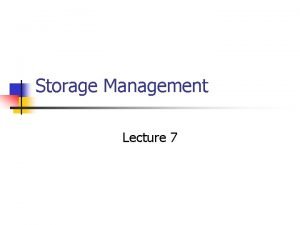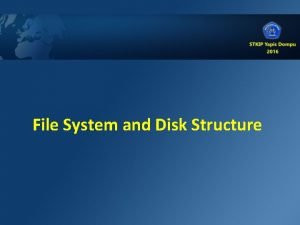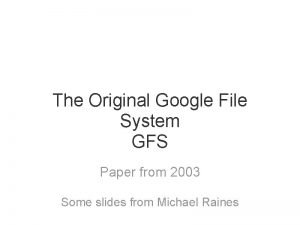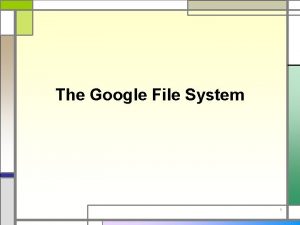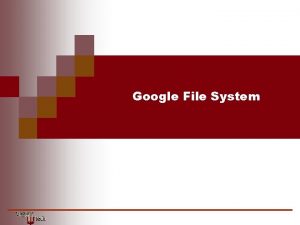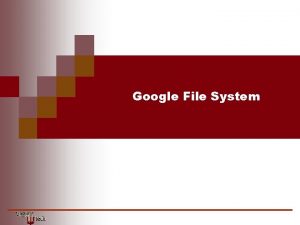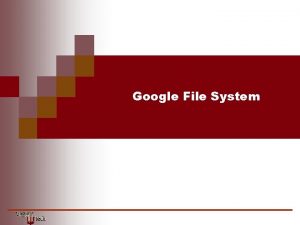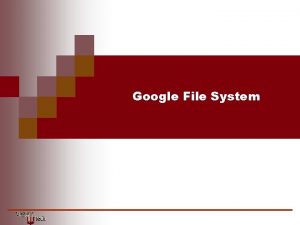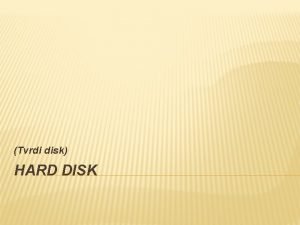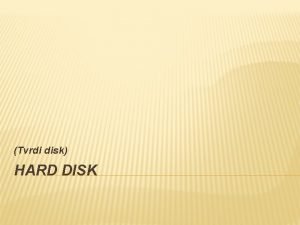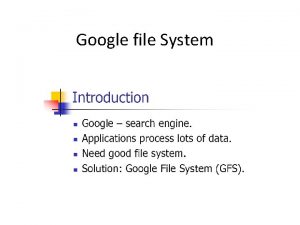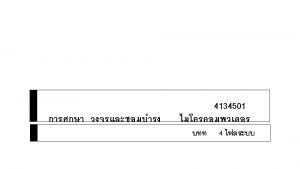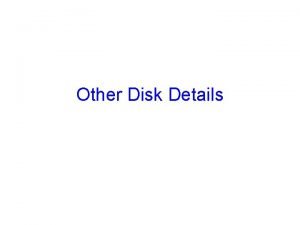Google File System Google File System Google Disk









- Slides: 9

Google File System

Google File System Google Disk Farm Early days… …today CS 5204 – Operating Systems 2

Google File System Design n Design factors Failures are common (built from inexpensive commodity components) ¨ Files ¨ n n n ¨ ¨ n large (multi-GB) mutation principally via appending new data low-overhead atomicity essential Co-design applications and file system API Sustained bandwidth more critical than low latency File structure chunk Divided into 64 MB chunks Chunk identified by 64 -bit handle Chunks replicated (default 3 file replicas) ¨ Chunks divided into 64 KB blocks ¨ Each block has a 32 -bit checksum ¨ ¨ ¨ CS 5204 – Operating Systems … blocks 3

Google File System Architecture metadata n Master ¨ ¨ n Manages namespace/metadata Manages chunk creation, replication, placement Performs snapshot operation to create duplicate of file or directory tree Performs checkpointing and logging of changes to metadata Chunkservers ¨ ¨ ¨ Stores chunk data and checksum for each block On startup/failure recovery, reports chunks to master Periodically reports sub-set of chunks to master (to detect no longer needed chunks) CS 5204 – Operating Systems 4

Google File System Mutation operations n Primary replica ¨ ¨ n Write operation ¨ ¨ ¨ n Holds lease assigned by master (60 sec. default) Assigns serial order for all mutation operations performed on replicas 1 -2: client obtains replica locations and identity of primary replica 3: client pushes data to replicas (stored in LRU buffer by chunk servers holding replicas) 4: client issues update request to primary 5: primary forwards/performs write request 6: primary receives replies from replica 7: primary replies to client Record append operation ¨ ¨ Performed atomically (one byte sequence) At-least-once semantics Append location chosen by GFS and returned to client Extension to step 5: n n If record fits in current chunk: write record and tell replicas the offset If record exceeds chunk: pad the chunk, reply to client to use next chunk CS 5204 – Operating Systems 5

Google File System Consistency Guarantees primary replica defined n consistent inconsistent Write Concurrent writes may be consistent but undefined Write operations that are large or cross chunk boundaries are subdivided by client into individual writes ¨ Concurrent writes may become interleaved ¨ ¨ n Record append ¨ ¨ ¨ n Atomically, at-least-once semantics Client retries failed operation After successful retry, replicas are defined in region of append but may have intervening undefined regions Application safeguards ¨ ¨ ¨ Use record append rather than write Insert checksums in record headers to detect fragments Insert sequence numbers to detect duplicates CS 5204 – Operating Systems 6

Google File System Metadata management Logical structure pathname /home lock read /save Chunk 8 ffe 07783, … /home/user/foo /home/user n Chunk 6254 ee 0, … read Chunk 88 f 703, … Logically a mapping from pathname to chunk list Allows concurrent file creation in same directory Read/write locks prevent conflicting operations File deletion by renaming to a hidden name; removed during regular scan Operation log ¨ ¨ ¨ n write Namespace ¨ ¨ n chunk list Chunk 4400488, … Historical record of metadata changes Kept on multiple remote machines Checkpoint created when log exceeds threshold When checkpointing, switch to new log and create checkpoint in separate thread Recovery made from most recent checkpoint and subsequent log Snapshot ¨ ¨ Revokes leases on chunks in file/directory Log operation Duplicate metadata (not the chunks!) for the source On first client write to chunk: n n n Required for client to gain access to chunk Reference count > 1 indicates a duplicated chunk Create a new chunk and update chunk list for duplicate CS 5204 – Operating Systems 7

Google File System Chunk/replica management n Placement On chunkservers with below-average disk space utilization Limit number of “recent” creations on a chunkserver (since access traffic will follow) ¨ Spread replicas across racks (for reliability) ¨ ¨ n Reclamation Chunk become garbage when file of which they are a part is deleted Lazy strategy (garbage college) is used since no attempt is made to reclaim chunks at time of deletion ¨ In periodic “Heart. Beat” message chunkserver reports to the master a subset of its current chunks ¨ Master identifies which reported chunks are no longer accessible (i. e. , are garbage) ¨ Chunkserver reclaims garbage chunks ¨ ¨ n Stale replica detection ¨ ¨ Master assigns a version number to each chunk/replica Version number incremented each time a lease is granted Replicas on failed chunkservers will not have the current version number Stale replicas removed as part of garbage collection CS 5204 – Operating Systems 8

Google File System Performance CS 5204 – Operating Systems 9
